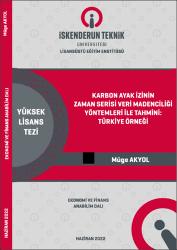| dc.contributor.advisor | Uçar, Emine | |
| dc.contributor.author | Akyol, Müge | |
| dc.date.accessioned | 2023-12-24T10:38:12Z | |
| dc.date.available | 2023-12-24T10:38:12Z | |
| dc.date.issued | 2022 | en_US |
| dc.identifier.citation | Akyol, M. (2022). Karbon ayak izinin zaman serisi veri madenciliği yöntemleri ile tahmini: Türkiye örneği. (Yüksek Lisans Tezi). İskenderun Teknik Üniversitesi / Lisansüstü Eğitim Enstitüsü / Ekonomi Finans Ana Bilim Dalı, Hatay. | en_US |
| dc.identifier.uri | https://hdl.handle.net/20.500.12508/2768 | |
| dc.description.abstract | Sürdürülebilir bir dünya için, iklim değişikliği ile mücadelede atılacak en büyük adım insani
faaliyetlerden kaynaklanan emisyonu azaltmaktır. Bu sebeple dünyaya salınan karbon
emisyonunun ölçüsü olarak kabul edilen karbon ayak izinin azaltılmasına yönelik çalışmalar
önem arzetmektedir. Bu doğrultuda yapılan çalışma, Türkiye’nin gelecek dönem sera gazı
emisyon oranlarının tahminini içermektedir. Çalışmada Türkiye’nin 1990-2017 yıllarına ait
nüfus, gayri safi yurt içi hasıla, enerji üretimi ve enerji tüketimi parametreleri kullanılarak
sera gazı emisyon oranlarının zaman serisi veri madenciliği yöntemlerinden Lineer
regresyon, Çok katmanlı algılayıcı ve Sıralı en düşük optimizasyon(SMOreg) algoritmaları
ile tahmini gerçekleştirilmiştir. Yapılan tahminlerden hata istatistikleri en küçük olan ve
gerçek değerlere en yakın değerleri veren SMOreg algoritması kullanılarak 2018-2030
yılları arasındaki sera gazı emisyon oranı tahmini yapılmış ve yapılan analiz sonucunda
Türkiye’nin günümüzdeki seyrini devam ettirdiği sürece sera gazı emisyon miktarının
kademeli olarak artarak 2030 yılında 728.301 metrik ton CO2 eşdeğerine ulaşacağı
bulgusuna erişilmiştir. İklim değişikliği ile ilgili uluslararası sözleşmelerin çoğunda yer alan
Türkiye için ulaşılan tahmin değerleri, Paris iklim sözleşmesinde taahhüt edilen oranın
altındadır. Bu durum Türkiye için umut verici olarak değerlendirilse de yapılan diğer
çalışmalardaki tahminler göz ardı edilmeden, politika yapıcıların bu doğrultuda politika
belirlemesi gerektiği düşünülmektedir | en_US |
| dc.description.abstract | For a sustainable world, the biggest step to be taken in the fight against climate change is to
reduce emissions from human activities. For this reason, it is important to work on reducing
the carbon footprint, which is accepted as the measure of carbon emissions released to the
world. In this direction, the study includes the estimation of Turkey's greenhouse gas
emission rates for the next period. In the study, the greenhouse gas emission rates of Turkey
were estimated using linear regression, multilayer perceptron and sequential minimal
optimization (SMOreg) algorithms from time series data mining methods, utilizing the
parameters of population, gross domestic product, energy production and energy
consumption for the years 1990-2017. The greenhouse gas emission rate between 2018 and
2030 was estimated by using the SMOreg algorithm, which has the smallest error statistics
and gives the closest values to the real values. As a result of the analysis, it has been found
that as long as Turkey continues its current course, the amount of greenhouse gas emissions
will increase gradually and reach 728,301 metric tons of CO2 equivalent in 2030. The
estimated values reached for Turkey, which is included in most of the international
conventions on climate change, are below the rate committed in the Paris climate
convention. Although this situation is considered promising for Turkey, it is thought that
policy makers should determine policies in this direction, without ignoring the estimates in
other studies | en_US |
| dc.language.iso | tur | en_US |
| dc.publisher | İskenderun Teknik Üniversitesi / Lisansüstü Eğitim Enstitüsü / Ekonomi Finans Ana Bilim Dalı | en_US |
| dc.rights | info:eu-repo/semantics/openAccess | en_US |
| dc.subject | Karbon ayak İzi | en_US |
| dc.subject | Yenilenebilir enerji | en_US |
| dc.subject | Zaman serisi veri madenciliği | en_US |
| dc.subject | SMOreg | en_US |
| dc.subject | Carbon footprint | en_US |
| dc.subject | Renewable energy | en_US |
| dc.subject | Time series data mining | en_US |
| dc.title | Karbon ayak izinin zaman serisi veri madenciliği yöntemleri ile tahmini: Türkiye örneği | en_US |
| dc.title.alternative | Carbon footprint forecasting using time series data mining methods: the case of Turkey | en_US |
| dc.type | masterThesis | en_US |
| dc.contributor.department | İşletme ve Yönetim Bilimleri Fakültesi | en_US |
| dc.identifier.startpage | IV | en_US |
| dc.identifier.endpage | 61 | en_US |
| dc.relation.publicationcategory | Tez | en_US |
| dc.contributor.isteauthor | Uçar, Emine | |
| dc.relation.index | İndeks Bilgisi Yok | en_US |
















